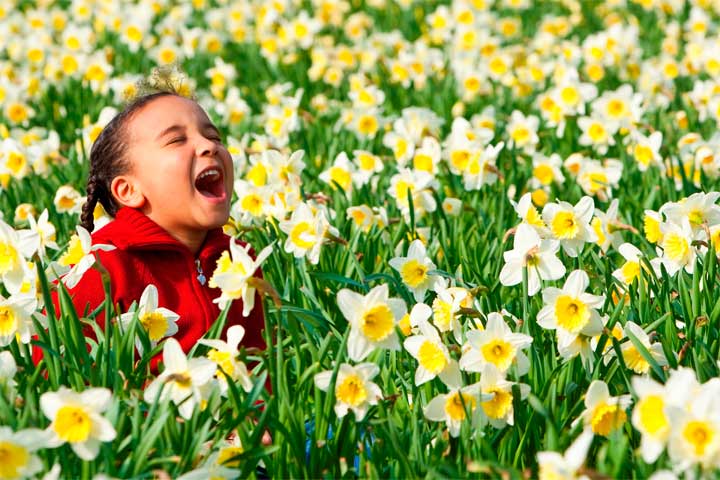
Pollen Explosion On Its Way, Hay Fever Rates On The Rise - Allergy NZ
1 September 2015, 12:54PM
Allergy NZ
While most people will be celebrating the end of what has been a long, cold winter, a third of the country will be clinging to their tissue boxes in preparation for the arrival of their seasonal allergic rhinitis – or hay fever.
This year, around 1.5m New Zealanders will sniff and sneeze their way through what Allergy New Zealand have coined The Allergy Season – Spring – and this number is growing. International predictions indicate in 10 years 50% of people will suffer hay fever*, primarily due to the effects of climate change.
“A recent study** has found elevated levels of carbon dioxide increases the amount of grass pollen produced per flower. This means airborne grass pollen concentrations are likely to increase significantly in the future as greenhouse gases rise,” says Allergy NZ’s CEO Mark Dixon.
“However, because pollen is not considered to be something that can be managed, there is no real monitoring of the situation in New Zealand. This is despite the fact that things like changes in farming practices, air pollution, city planning, development of public green spaces and climate change are all directly impacting and increasing the number of people who suffer from hay fever in this country***,” Dixon says.
Allergic rhinitis has been found to be an extremely common trigger for asthma in both children and adults – it can exacerbate asthma and make diagnoses more difficult. Patients with allergic rhinitis also suffer more frequent and prolonged respiratory infections, which can mean time away from work for adults and school for young people.
Persistent symptoms and poor quality sleep can result in lethargy, poor concentration and behavioural changes. It can increase sleep apnoea. It can impact learning for young children.
“In New Zealand allergies are not regarded as a significant health condition in spite of the numbers affected and increase in severity and complexity. PHARMAC for instance doesn’t have an allergy advisory sub-committee or any allergy specialists involved on other committees. Yet the World Health Organisation has declared chronic respiratory diseases, including allergic rhinitis, as one of the four major health problems affecting mankind.
“This is a major issue for the health sector, particularly in regards to funding for allergy-related pharmaceuticals. The Ministry of Health’s web site, for example, recommends three treatments for moderate/severe allergies, two of which - immunotherapy and adrenaline auto-injectors for anaphylaxis - are not funded.
“This Allergy Season, Allergy New Zealand is appealing to the Government to investigate the significant hidden socio-economic impact allergic rhinitis has on patients and their families,” Dixon says.
While allergic rhinitis can occur all year round, most commonly aggravated by house dust mites which thrive in New Zealand’s mouldy, unventilated houses, the incidence increases dramatically with the arrival of 1 September, signalling the official start of Spring. This is due to the increased presence of wind-borne pollen from grass and trees.
Per capita, New Zealand is among the highest hay fever-suffering countries in the world. Symptoms range from a runny, stuffy and itchy nose with frequent sneezing to nausea, dizziness and recurrent throat, ear and sinus infections.
“Significantly more support is needed to provide education and resources for health professionals and patients in order to improve diagnosis, treatment and effective management. We need to reduce the burden and suffering on such a large section of the population.
“The primary health sector in NZ is largely ignorant of allergy diagnosis and management. Nor does the Government want to shift the cost of providing healthcare to these taxpayers. The issue with this attitude is that the cost is then passed on to sufferers, both financially and in their quality of life,” Dixon says.
Auckland Allergy Specialist Dr Andrew Baker says many New Zealanders with allergic rhinitis unfortunately rely on self-diagnosis and over-the-counter medications.

Photo courtesy of Allergy NZ
“Most people don’t know exactly what it is they are allergic to. As such, self- and misdiagnosis are rampant in New Zealand. Many rhinitis and asthma sufferers don’t know there is a treatment called desensitisation – which can actually decrease allergy symptoms in the long term, improving nose, eyes and airways, and continuing to work for years after the treatment stops. Studies now show desensitisation can actually decrease a child’s propensity to asthma, and can decrease the chance of new allergies developing.” Baker says.
Regarding the time of year sufferers will be most affected, in early Spring symptoms point to tree pollen, while nasal allergy in late Spring and Summer indicates grass and weed pollens are the culprits. Overlapping this is the weed pollen season, which usually starts in late Spring and extends through to the end of summer.
The overall burden of hay fever is better understood when you consider 50 per cent of those with allergies experience symptoms for more than four months a year – The Allergy Season – and 20 per cent have symptoms for at least nine months every year. The rest unfortunately suffer all year round.
Allergy New Zealand recommends sufferers see a doctor and possibly a specialist, rather than self-prescribing, as their symptoms are often made more manageable with correct diagnosis and treatment.
All allergies must be taken seriously as many, if not already life threatening, can develop into more serious problems for the individual.
The Allergy Season is Allergy New Zealand’s annual awareness campaign. It kicks off on 1 September with a focus on Hay Fever. The Allergy Season then targets Eczema awareness in October and then from November until Christmas will focus on food allergies.
Website: www.allergy.org.nz
*EAACI 2015
**Albertine J et al. Projected Carbon Dioxide to Increase Grass Pollen and Allergen Exposure Despite Higher Ozone Levels. PLOS ONE, Nov 2014
***Cecchi, L et al. Projections of the effects of climate change on allergic asthma: the contribution of aerobiology. 2010 John Wiley & Sons A/S
